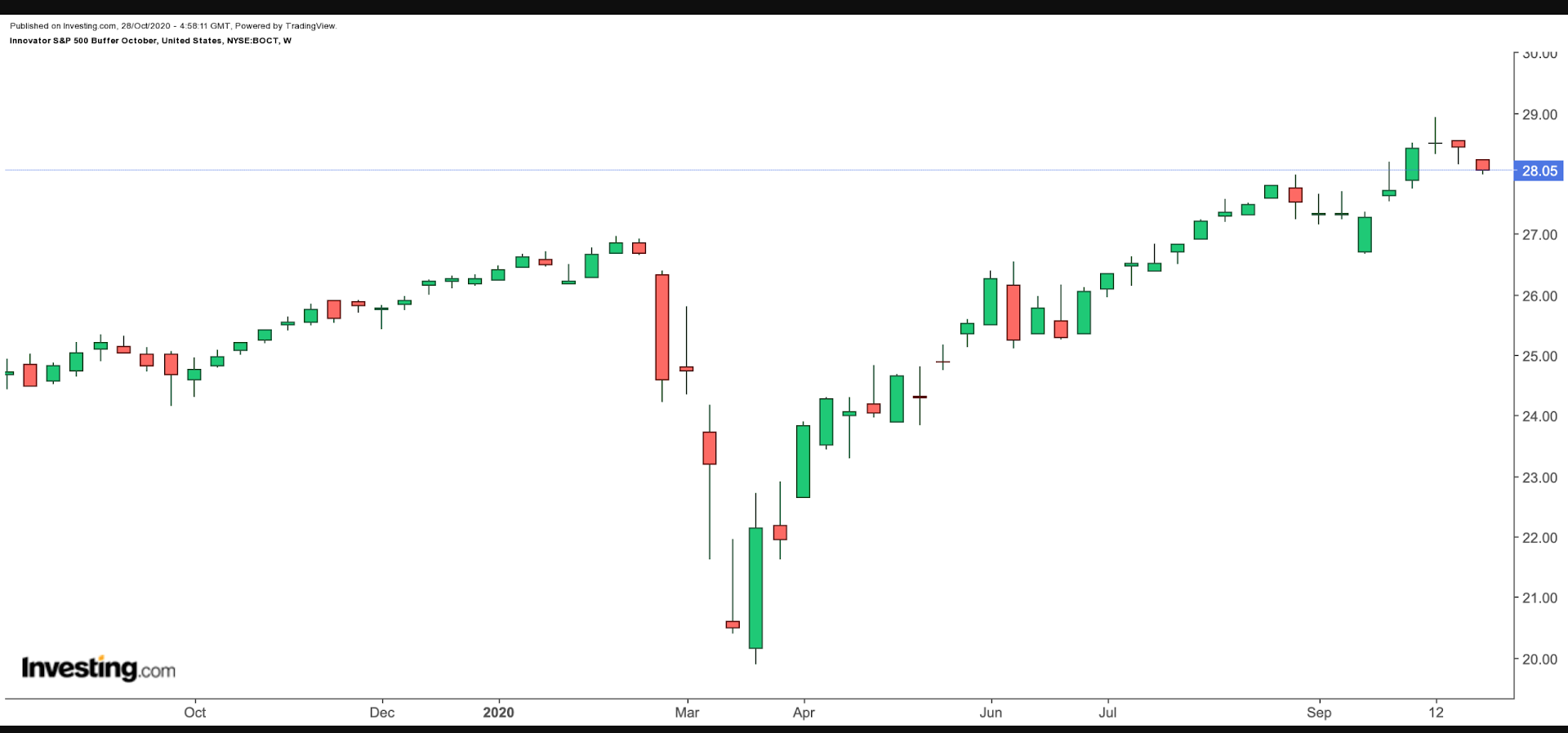2020 has become the year when the balance between portfolio risk and reward is increasingly important. Fund sponsors have started offering a wide range of actively-managed ETFs, including buffered ETFs.
Also known as defined outcome, target outcome or structure ETFs, these funds may help mitigate risk and lower portfolio volatility. Given the market choppiness, investor interest in these products is mounting as they seek equity market growth, with reduced downside risk.
Buffered ETFs, first launched in 2018, offer a level of protection (or buffer) in down markets while also giving capped-exposure and thus limited growth in up markets.
The terminology in fund prospectuses may at first look confusing, but there are a few key points potential investors should pay close attention to before adding these products to portfolios.
Let's take a closer look:
Innovator S&P 500 Buffer October ETF
- Current Price: $28.04
- 52-Week Range: $19.89 - $28.94
- Expense Ratio: 0.79%
Innovator Capital Management was the first fund sponsor to launch buffered ETFs in 2018. The group now offers a wide range of such structured funds. Other fund sponsors also offer similar products.
Market Index
Like most other ETFs, buffered funds track the price returns of a specific index, such as the S&P 500, NASDAQ 100, Russell 2000, or MSCI EAFE. New ETFs tracking other indices join the fray regularly.
The Innovator S&P 500 Buffer October (NYSE:BOCT) tracks the S&P 500 index.

Outcome period
Buffered ETFs typically track the targeted index for a year. This timeframe is the outcome period. Fund sponsors usually list either a monthly or quarterly series of these structured funds.
As the name implies, the Innovator S&P 500 Buffer October ETF, which was rebalanced on Oct. 1., is part of a monthly series of funds. For instance, the Innovator S&P 500 Buffer November ETF (CBOE:BNOV) will be rebalanced on Nov. 1.
Capped Upside Growth
These target outcome ETFs offer capped potential gains. For the Innovator S&P 500 Buffer October ETF, the starting cap on Oct. 1 was 18.30%.
Put another way, even if the S&P 500 index were to, for example, double in value between Oct. 1, 2020 and Sept. 30, 2021, the maximum return of BOCT would be 18.30% (minus the expense ratio of 0.79%).
Buffered ETFs can be bought or sold at any point in a trading day. However, it is important to underline that this stated cap level applies only when bought on the first day of rebalancing, Oct. 1 in this case.
After the new period has begun, those who buy the fund may not necessarily achieve the maximum return.
Buffered Downside Loss
These funds also come with a built-in protection against potential losses. A given fund's prospectus highlights the buffered amount beyond which investors are subject to losses. This stated buffered amount is usually a percentage of the net asset value at the beginning of the one-year outcome period.
For the Innovator S&P 500 Buffer October ETF, the starting buffer on Oct. 1 was 9%. Thus the value of the fund will not decrease until after the underlying S&P 500 declines by 9%.
Products Included
To achieve its objective, such a fund typically holds an actively managed basket of Flexible Exchange® Options (or FLEX Options). These options have different strike prices and the same expiration date.
We discussed several hedging strategies or speculative bets using covered calls with LEAP options, straight put purchases, and put spreads in previous articles. We also looked at ETFs that utilize options as part of their strategies.
The detailed options strategy in buffered options is beyond the scope of this article. In simple terms, fund managers devise a strategy somewhat similar to a collar (but not fully). As a result, the payoff structure is known at option expiry. However, how a given ETF may perform on a given day during the year cannot be known fully.
On a final note, because the strategy uses options, investors also sacrifice any dividend yield offered by the index.
Bottom Line
Each market participant has a unique set of objectives, resources, and constraints. However, given the current health and economic concerns, risk management is important.
Diversification may help decrease portfolio volatility and achieve respectable returns. Buffered ETFs may also have a role to play in a wide range of retail portfolios. However, their risk/return profile is different than a typical buy-and-hold strategy.
For example, such funds may appeal to market participants who would like to invest for a shorter timeframe, such as a year or two, but are nervous about risking their capital. In such a case, another ETF, such as the Innovator S&P 500 Ultra Buffer November ETF (CBOE:UNOV), can offer increased peace of mind. Its risk buffer is 30%, while its starting growth cap is shy of 8%.
Academic research and real-life market evidence from indices such as the S&P 500 show that buy-and-hold investors who stay invested in the market for several years or decades may not always see an increased benefit from such hedging strategies, which, by definition, always come at a cost.
Defined outcome funds are a relatively new concept. Those investors interested in these products may want to observe various monthly and quarterly series based on diverse indices.
If investors are not clear about buffered funds' suitability for their portfolios, they should talk to a financial planner in their respective countries. For US-based investors, defined outcome ETFs may also have different end-of-year tax consequences.
